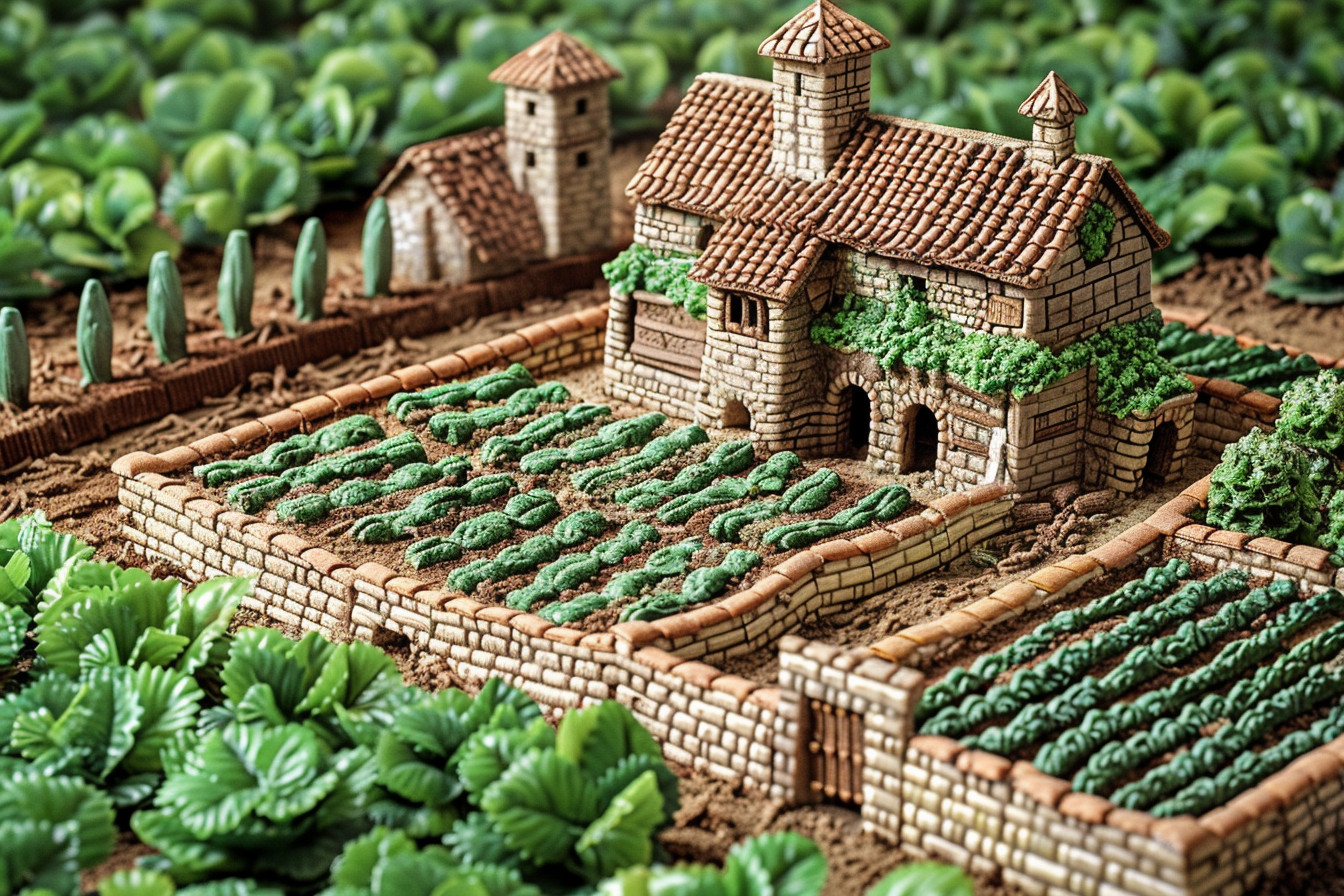Everdell is a stunningly beautiful board game that is filled with deep strategy. Players are taken into an enchanted world composed entirely of wood, where life-like creatures live peaceably side by side with simple and natural elements. It was designed by James A. Wilson and is beautifully illustrated by Andrew Bosley. Everdell is a worker placement and tableau-building game in which players compete to build the most prosperous city in all of Everdell. Combining elements of strategic play, resource management, and chance has made Everdell a favorite among serious board game enthusiasts who like their game a deep set of aesthetics.
The world in which Everdell dwells is captivating from the get-go. Players are introduced to this world via a three-dimensional tree that sits on the game board; for the first time in gaming what you’ve been dreaming of as an experience is really here! This tree actually has function, too as it holds the deck and shows events. The game board is the forest floor itself in all its lush illustration where players put down in their critter-runners and try to build cities.
Everdell is designed for one to four players, taking about 40-80 minutes to play. It proceeds through four seasons which start with winter and end in autumn. Each season brings new challenges and opportunities, reflecting the dynamic nature of a thriving forest city. The game’s components comprise several types of critter and construction cards, counters that stand for resources like berries, twigs, resin, and rocks, and the aforementioned Evertree, which enriches the game by adding an extra dimension at its very beginning.
Everdell stands out from other strategy games with it’s unique blend of strategy and storytelling. It encourages players to think critically about their moves while also offering a deep dive into the beguiling world of Everdell. Every game plays out like a new story, with different critters and constructions combining to form a different city each time. The artwork quality and parts make the whole experience, not just a game but a trip into a magical forest where even your slightest decision matters.
Set-up
The setting up of Everdell is part of its charm, but with so many components and so many details to all the various parts it can be somewhat overwhelming for new players. But once you learn the ropes, getting set up itself becomes an enjoyable prelude to playing the game.
First, assemble the Evertree. You slot together the cardboard pieces to build a tree that stands on the game’s main board. While it may look mainly decorative it plays a vitally important part in the game’s organization: the Evertree holds your forest card deck on its branches and displays special event cards that players aim to fulfill.
Next, lay out the main game board. This is a board laid with beautiful art representing the forest floor, featuring spaces to place forest cards, event cards and resource tokens. Around the board, position your resource tokens: berries, twigs, resin and pebbles. You need these to build constructions and recruit critters into your city. Each player takes a set of worker tokens, represented by different woodland creatures such as squirrels or turtles and hedgehogs, and places them near their private reserve area.
Shuffle the deck of main critter cards and construction cards, then deal out eight of these face up into the Meadow, a communal area where everyone can hire new recruits. Each player also draws five cards from the draw pile in preparation for their city’s development.
Then place four season markers on Evertree, Winter at its base, then Spring, Summer and finally Autumn which move upward along this tree while you work through each period of the year. Depending upon how far along players can reach this year–different rounds, and the different cards and resources they earn accordingly.
Now, earlier stage settings can seem a little much and hard to grasp at first view. This bit of the game though is just part but very important for understanding it as your first step into Everdell. Beginning everything together with friends or family highlights one nice feature about Everdell’s detailed preparation: setting up the game makes itself an enjoyable activity in its own right and will help to whet your appetite thoroughly for what is sure be a successful experience.
Everdell’s gameplay is a wonderful fusion of card drafting and tableau construction, offering players a rich strategic experience that changes as the game progresses. Your goal is to build the most profitable citypossible over the preceeding roundand a half: you gain points by playing a wide variety of critter and construction cards.
At the beginning, each player only has a few workers and resources for the whole season. Every turn, players can put down a worker at any point of the board to gather resources, draw cards or perform other special moves. The worker placement system is simple but there is a lot of strategy, because every one of these choices will have a significant impact on what happens next for you. Are you going to collect berries to recruit a critter, or take twigs and resin for building? Every one of these choices must be made according to your current needs and eventual plans.
As you gather resources, critters and constructions cards from your hand or the Meadow go into your flourishing city. The unique powers and victory points of each card may be quite different; many cards also work together. Husband and wife critters, for example, go well. You will get additional benefits if both husband and wife critters are in your city. And with constructions like the Inn or the Post Office, certain actions and features can be of vital importance to the development of your strategy.
One of the things I particularly enjoy about Everdell is the way the game changes with each new season. At the end of winter, players will enter spring with a lot more workers and maybe some new resource (which they may now need less than others). The introduction of this seasonal character adds another dimension to playing the game, as players must adjust and pay attention accordingly. In spring there will be more chances for getting resources, while in summer it becomes mostly about building and recruitment.
Pros
Everdell has won fans for a number of reasons, each contributing to its position as a favorite among gamers. The visual appeal of the game stands out. Andrew Bosley’s artwork is simply sensational with pictures like those on each card depicting endearing and skillful animal constructions. The 3D Evertree adds an extra layer of reality to the game making it feel as if the trees grow around you.
Another major pro is the game’s accessibility and strategy mix. Everdell provides deep and strategic play, yet remains approachable to the newer player. The rules are quite clear: even one hour after playing you should have a grip on most everything. Still advanced gamers keep being drawn in by the strategic richness to be found in them. This balance makes Everdell a game with wide appeal one that can fit people of all sorts.
Everdell offers high replay value. The game cards for animals and buildings and the different arrangements of forest event maps mean that no two games will ever be the same. Each round presents a fresh test of skill new tricks and areas for exploration.
Cons
Everdell is an attractive game, but it can be a little too slow. In the early game, players are not well motivated due to having limited options. However, after they get their first resources and workers accumulate over several turns, or more often three years cycles on Acorn Hill itself- suddenly everything seems to accelerate significantly for them especially by volume of resource or the points they have been awarded at Harvest time. This uneven pacing has a way of leaving the opening turns feeling less engaging, and can therefore be seen as a negative feature particularly for gamers who like activity levels in the game to remain fairly consistent.
Player interaction in Everdell is also limited. Although there are resources and events which players can compete for, much of the game is spent developing their own city. A more solitary game results from this where players are primarily concerned with their own tableau rather than directly interacting on an opponent’s territory. This makes tabletop wargames very much single player but two or four others in Everdell would be “at best” a happy fantasy (and quite possibly a requirement for every game of such sort). Could it not do with some kind of cooperative expansion that helped overcome these limitations?
The final possible drawback to Everdell is that it may prove a bit much for people not too familiar with worker placement or tableau building games. All of the many choices and strategies available can be confounding. Also,the gameʻs depth might be intimidating to those seeking something lighter in their gaming experience. You may find that while the game does offer many layers of strategy, it isn’t necessarily a perfect fit for every player and particularly not those who prefer simpler or more casual games.
Final Thoughts
Everdell was helped into the top entry by being a board game that wonderfully combines strategic depth, aesthetics and storytelling with setting. The moment you start setting up the game board, you’re chilled and charmed by this enchanting forest town of Everdell, where a community of small animals and buildings form a living city that sways vividly with life. Fine art and high quality components make it a delight to play, and deep strategic gameplay will keep you engaged all the way through the game.
With its design and beautiful illustrations, Everdell could equally be played by casual gamers seeking something lighthearted as well as experienced experts in the field hoping for more of an intellectual challenge. The game’s mechanics are easy enough to permit novices, but it has sufficient depth and chance variation not to wear out experienced players over time. Through seasonal progressions as well as a combination of worker placement (“Workers need tools so that they can work — for you!”) and tableau-building that changes with each decision, this dynamic game keeps players busy constantly changing new challenges.
However, criticising Everdell is fairly futile because it is so enjoyable and engaging as a whole. These shortcomings are negligible when seen in the context of how much fun everyone will have!
Everdell’s greatest strength is that it draws you in. Every element of the game-feel, from token illustrations to the function of the cards, works together with such integration that playing a round feels as if you were telling a story in instalments. Whether you like strategy games, beautiful board games with inviting art or just to immerse yourself in what is happening on your turn all the time, Everdell is truly one of those games which should not go unplayed.
All told, Everdell is not just a board game. It is venturing into the magical forest where every move counts and each playthrough tells a different tale. The game is a stand-out experience for the rich mixture of strategy, visual attractiveness, and thematic coherence. Everdell continues to triumph time and time again with players. If you are building a thriving city of creatures or competing for scarce resources, Everdell gives a gratifying and unforgettable gaming experience.




